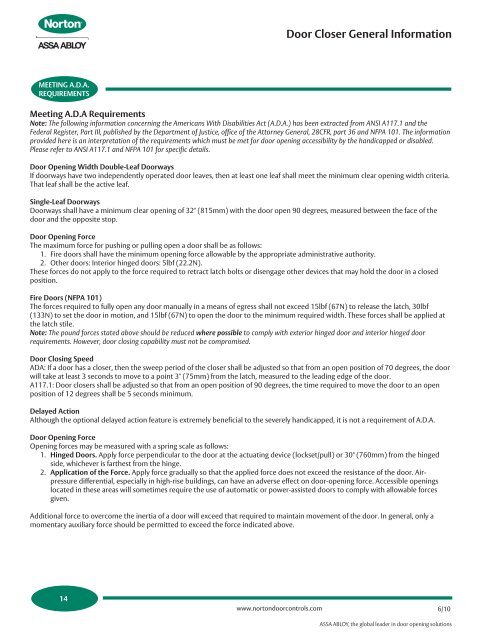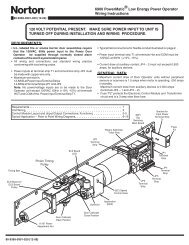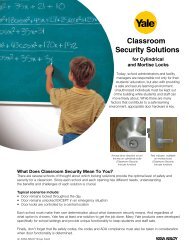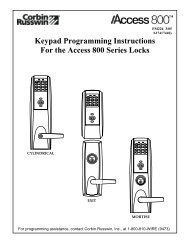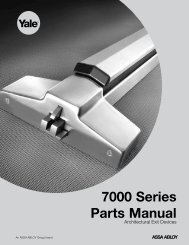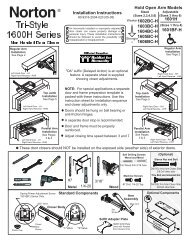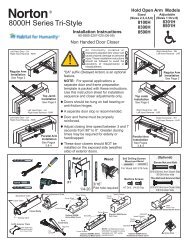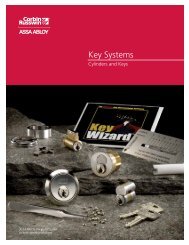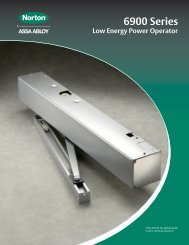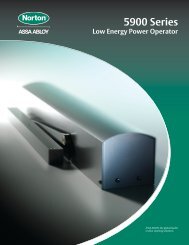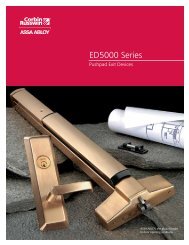General Information Guide - ASSA ABLOY Door Security Solutions ...
General Information Guide - ASSA ABLOY Door Security Solutions ...
General Information Guide - ASSA ABLOY Door Security Solutions ...
You also want an ePaper? Increase the reach of your titles
YUMPU automatically turns print PDFs into web optimized ePapers that Google loves.
meeTING A .D .A .<br />
reqUIremeNTS<br />
14<br />
<strong>Door</strong> Closer <strong>General</strong> <strong>Information</strong><br />
meeting A .D .A requirements<br />
Note: The following information concerning the Americans With Disabilities Act (A.D.A.) has been extracted from ANSI A117.1 and the<br />
Federal Register, Part III, published by the Department of Justice, office of the Attorney <strong>General</strong>, 28CFR, part 36 and NFPA 101. The information<br />
provided here is an interpretation of the requirements which must be met for door opening accessibility by the handicapped or disabled.<br />
Please refer to ANSI A117.1 and NFPA 101 for specific details.<br />
<strong>Door</strong> Opening Width Double-Leaf <strong>Door</strong>ways<br />
If doorways have two independently operated door leaves, then at least one leaf shall meet the minimum clear opening width criteria.<br />
That leaf shall be the active leaf.<br />
Single-Leaf <strong>Door</strong>ways<br />
<strong>Door</strong>ways shall have a minimum clear opening of 32" (815mm) with the door open 90 degrees, measured between the face of the<br />
door and the opposite stop.<br />
<strong>Door</strong> Opening Force<br />
The maximum force for pushing or pulling open a door shall be as follows:<br />
1. Fire doors shall have the minimum opening force allowable by the appropriate administrative authority.<br />
2. Other doors: Interior hinged doors: 5lbf (22.2N).<br />
These forces do not apply to the force required to retract latch bolts or disengage other devices that may hold the door in a closed<br />
position.<br />
Fire <strong>Door</strong>s (NFPA 101)<br />
The forces required to fully open any door manually in a means of egress shall not exceed 15lbf (67N) to release the latch, 30lbf<br />
(133N) to set the door in motion, and 15lbf (67N) to open the door to the minimum required width. These forces shall be applied at<br />
the latch stile.<br />
Note: The pound forces stated above should be reduced where possible to comply with exterior hinged door and interior hinged door<br />
requirements. However, door closing capability must not be compromised.<br />
<strong>Door</strong> Closing Speed<br />
ADA: If a door has a closer, then the sweep period of the closer shall be adjusted so that from an open position of 70 degrees, the door<br />
will take at least 3 seconds to move to a point 3" (75mm) from the latch, measured to the leading edge of the door.<br />
A117.1: <strong>Door</strong> closers shall be adjusted so that from an open position of 90 degrees, the time required to move the door to an open<br />
position of 12 degrees shall be 5 seconds minimum.<br />
Delayed Action<br />
Although the optional delayed action feature is extremely beneficial to the severely handicapped, it is not a requirement of A.D.A.<br />
<strong>Door</strong> Opening Force<br />
Opening forces may be measured with a spring scale as follows:<br />
1. Hinged <strong>Door</strong>s . Apply force perpendicular to the door at the actuating device (lockset/pull) or 30" (760mm) from the hinged<br />
side, whichever is farthest from the hinge.<br />
2. Application of the Force . Apply force gradually so that the applied force does not exceed the resistance of the door. Air-<br />
pressure differential, especially in high-rise buildings, can have an adverse effect on door-opening force. Accessible openings<br />
located in these areas will sometimes require the use of automatic or power-assisted doors to comply with allowable forces<br />
given.<br />
Additional force to overcome the inertia of a door will exceed that required to maintain movement of the door. In general, only a<br />
momentary auxiliary force should be permitted to exceed the force indicated above.<br />
www.nortondoorcontrols.com 6/10


